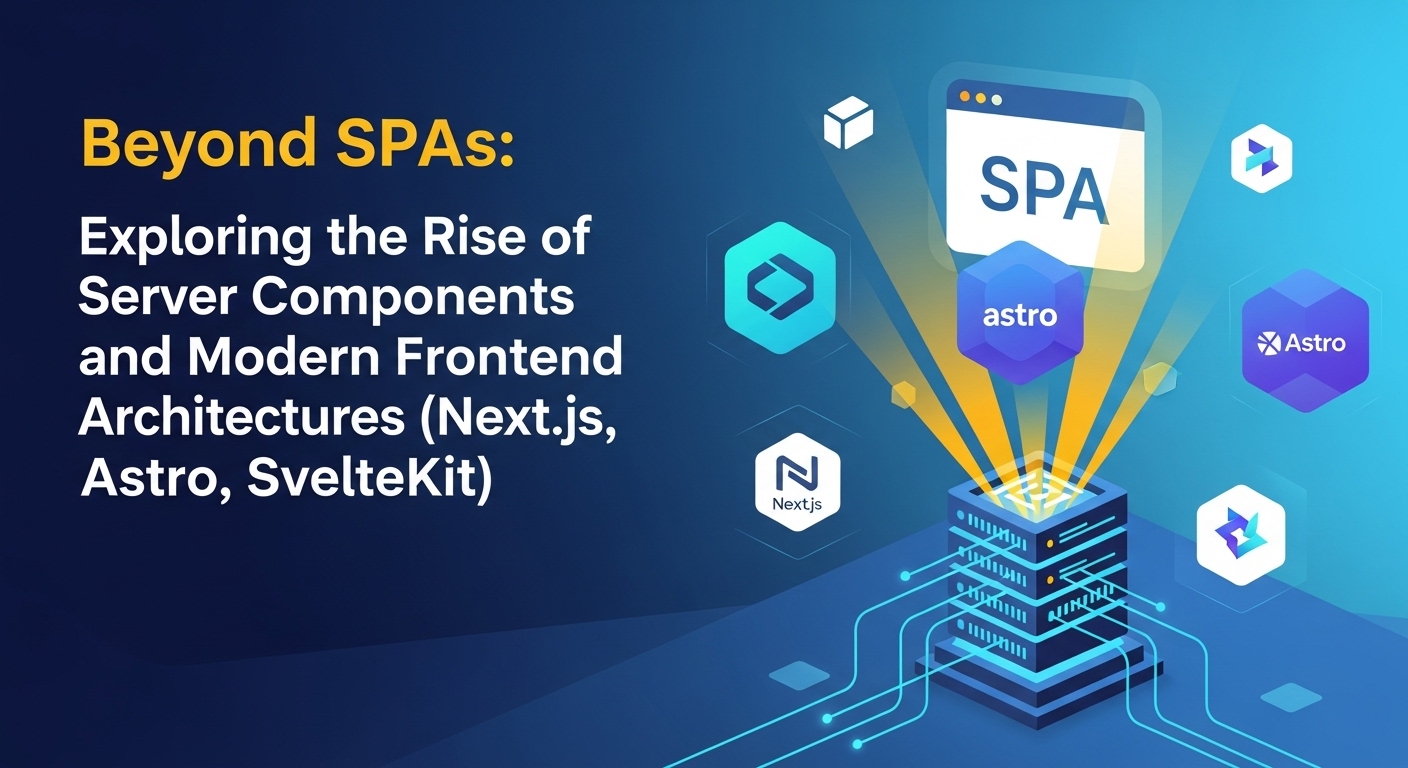The Era of the SPA and Its Unintended Consequences
For the better part of a decade, the Single-Page Application (SPA) has been the undisputed king of frontend development. Frameworks like React, Angular, and Vue empowered us to build incredibly rich, interactive, and app-like experiences directly in the browser. They solved the clunky, full-page reloads of the past and ushered in an era of dynamic user interfaces. By moving logic to the client-side, we created a faster, more fluid user experience. But as our applications grew in complexity, so did the cracks in the SPA model begin to show.
We started shipping massive JavaScript bundles to our users, often leading to slow initial page loads and a frustrating blank screen. Time to Interactive (TTI), a critical performance metric, suffered. We wrestled with complex state management libraries and fought battles with search engine crawlers that struggled to index our client-rendered content. The very model that gave us interactivity started to become a performance bottleneck. It became clear that sending an entire application to the client just to render a single page wasn’t always the most efficient approach. This realization has sparked a renaissance in frontend architecture, a move back towards the server, but with a modern twist.
A Paradigm Shift: The Rise of Server-Centric Architectures
The new wave of frontend thinking isn’t about abandoning the client; it’s about finding a more intelligent balance. It’s about leveraging the server for what it does best—data fetching and rendering static content—while reserving the client’s power for what it was meant for: rich interactivity. This shift is powered by concepts like Server Components and the Islands Architecture, championed by a new generation of powerful frameworks.
What Exactly Are Server Components?
First introduced by the React team, React Server Components (RSCs) represent a fundamental change in how we think about building UIs. Unlike traditional components that render on the client, Server Components execute exclusively on the server. They have direct access to your backend resources—databases, file systems, internal APIs—without needing to expose API endpoints.
The magic is that they render to an intermediate, abstract format that can be streamed to the client. Crucially, Server Components ship zero JavaScript to the browser by default. This means faster initial loads and a significantly smaller client-side footprint. Interactivity is then opted into by using Client Components (marked with a 'use client' directive), which work just like the React components we’re used to. This allows for a surgical approach to interactivity, rather than a blanket one.
The Islands Architecture: Hydrating in Isolation
Another powerful concept is the Islands Architecture, popularized by the framework Astro. Imagine your web page as an ocean of static, server-rendered HTML. This HTML is fast to load and requires no JavaScript to display. Within this ocean, there are small, isolated ‘islands’ of interactivity—a carousel, a search bar, a ‘buy now’ button. These islands are the only parts of the page that get ‘hydrated’ with JavaScript, meaning they become interactive on the client. The rest of the page remains pure HTML. This approach drastically reduces the amount of JavaScript shipped, leading to phenomenal performance, especially for content-heavy websites like blogs, marketing sites, and e-commerce storefronts.
The Modern Vanguard: Frameworks Leading the Charge
This architectural evolution isn’t just theoretical. A new crop of frameworks has emerged, building these powerful concepts into their core. Let’s explore the three most prominent players mentioned in the title.
Next.js: The Full-Stack React Powerhouse
Next.js, particularly since the introduction of its App Router, has fully embraced the React Server Components model. It has redefined what it means to build a full-stack React application.
Key Features:
- Server Components by Default: In the App Router, every component is a Server Component unless you explicitly opt-out with
'use client'. This encourages developers to think server-first, minimizing the client-side bundle size from the get-go. - Seamless Data Fetching: You can use
async/awaitdirectly within your Server Components to fetch data. No more `useEffect` hooks for data fetching, no more client-side request waterfalls. The data is fetched on the server, and the rendered HTML is streamed to the client. - Hybrid Rendering: Next.js still provides the flexibility to mix and match. You can have static pages, server-rendered pages, and client-rendered components all co-existing within the same application, giving you the best tool for every job.
Next.js is an excellent choice for complex, data-driven web applications where the power of the React ecosystem is a must, but performance remains a top priority.
Astro: The Content and Performance Champion
Astro was built from the ground up around the Islands Architecture. Its primary goal is to deliver the fastest possible experience by shipping the least amount of JavaScript necessary.
Key Features:
- Zero JS By Default: This is Astro’s mantra. It renders your entire site to static HTML, and any JavaScript for interactive components (the islands) is loaded on-demand.
- UI Framework Agnostic: Love React, Svelte, or Vue? No problem. Astro lets you bring your favorite component framework to build your interactive islands. You can even mix and match them on the same page.
- Content-First Focus: With features like first-class Markdown support and content collections, Astro is purpose-built for content-heavy sites. It makes building blogs, documentation sites, and marketing websites an absolute joy.
If your project is a content-driven website and your number one goal is raw performance and top-tier SEO, Astro is an incredibly compelling choice.
SvelteKit: Compiler Magic Meets Full-Stack Flexibility
SvelteKit is the official full-stack framework from the creators of Svelte. While it doesn’t use ‘Server Components’ in the same way React does, it achieves similar goals through a different, equally powerful approach centered around its compiler.
Key Features:
- Compiler-Driven Performance: Svelte itself is a compiler that turns your declarative component code into highly optimized, vanilla JavaScript at build time. This results in incredibly small bundle sizes and blazing-fast runtime performance.
- Powerful Data Loading: SvelteKit has a clear and powerful data-loading pattern using `load` functions that can run on the server, the client, or both. This gives developers fine-grained control over how and when data is fetched, preventing waterfalls and ensuring a smooth user experience.
- Flexible Rendering: Like Next.js, SvelteKit offers a spectrum of rendering options, from pre-rendering pages at build time (SSG) to server-side rendering (SSR) on request, and client-side navigation for that SPA-like feel after the initial load.
SvelteKit is perfect for developers who value developer experience, want top-tier performance out of the box, and need a flexible framework that can scale from a simple landing page to a complex application.
Conclusion: The Future of Frontend Development is a Smart Balance
The move beyond the traditional SPA model is not a rejection of client-side interactivity. Instead, it’s a mature evolution of frontend development. We’ve learned that the ‘one-size-fits-all’ approach of client-side rendering everything has its limits. The future is hybrid. It’s about making deliberate, architectural choices. It’s about using the server to render static content and fetch data efficiently, while leveraging the browser for the rich, dynamic interactions that users love.
Frameworks like Next.js, Astro, and SvelteKit are not just new tools; they represent a new way of thinking. They empower us to build faster, more resilient, and more SEO-friendly web applications without sacrificing the user experience. As you embark on your next project, take a moment to look beyond the traditional SPA. Explore these modern architectures—your users, and your Lighthouse scores, will thank you for it.


